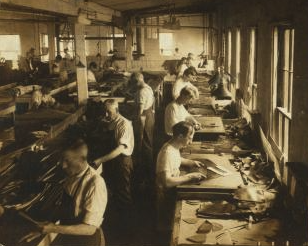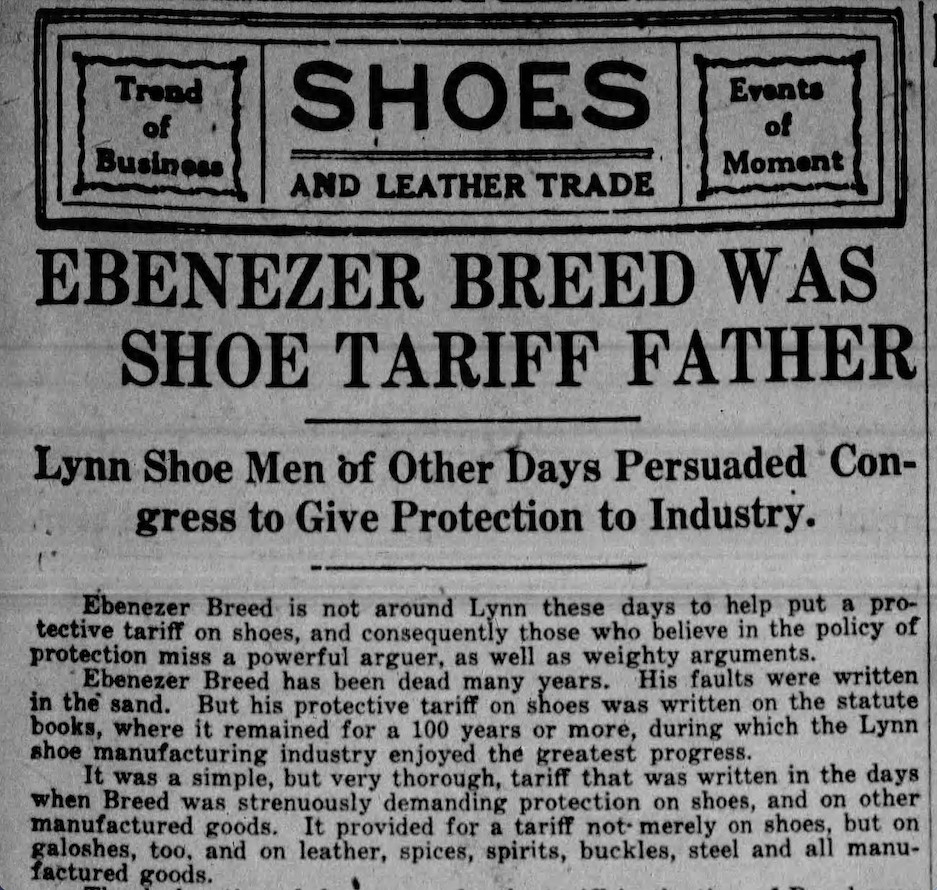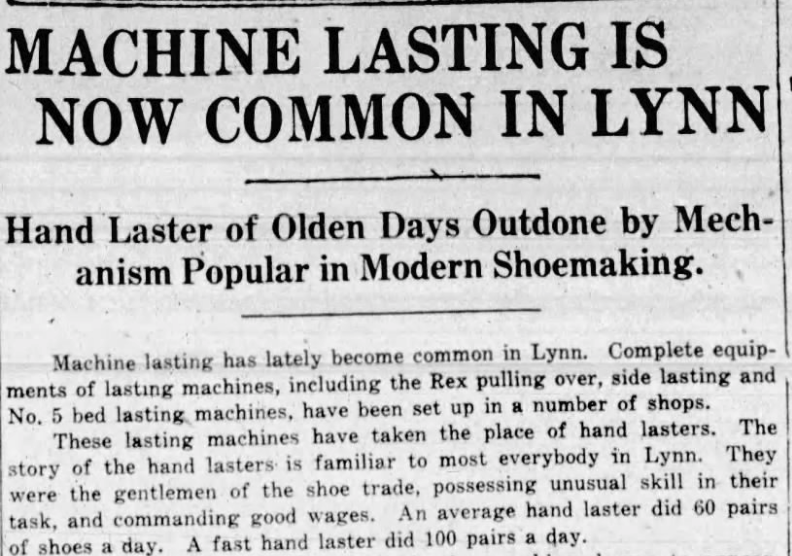If you have ancestors from Lynn, Massachusetts, we are pleased to announce the addition of The Daily Item to our archives. With issues dating back to 1877, you can search through nearly one and a half centuries of Massachusetts history.
In 1629, Salem colonist Edmund Ingalls and four others settled the town of Saugus. Shortly after that, the first colonial tannery began operating. In 1637, Saugus was renamed Lynn in honor of Samuel Whiting, the first minister in the area. He hailed from King’s Lynn, England.
Lynn was predominantly an agricultural town, but by 1775, numerous tanneries were operating along Black Marsh Brook (also called Tannery Brook). The tanneries spawned a leather shoemaking industry. In fact, during the Revolutionary War, boots worn by Continental soldiers were made by Lynn craftsmen. Shoemaking is at the heart of the town’s heritage and is reflected in the city’s seal, which includes a colonial boot.
A local Lynn Quaker, Ebenezer Breed, traveled to Philadelphia and successfully lobbied to impose tariffs on shoes and boots from European nations. As war continued in Europe, American-made shoes rose in demand and helped Lynn become a major shoe center.
In 1837, the Eastern Railroad extended from Boston to Salem through Lynn. The railroad further bolstered the growth of their shoe industry and became the catalyst for creating a factory district. On September 28, 1841, abolitionist Frederick Douglass was removed from his railroad car at Lynn Central Station when he refused to sit in a segregated coach. Douglass ended up moving to the area.
The prosperity of Lynn’s shoe industry continued through the Civil War and thrived despite fires in 1869 and 1889 that destroyed swaths of businesses. After the 1869 fire, multi-story shoe factories replaced the burned buildings.
Attaching the upper part of a shoe to the sole was a lengthy manual process performed by an artisan called a ‘hand laster.’ In the late 1800s, it took an experienced hand laster ten hours to complete 50 pair of shoes. In 1882, Jan Ernst Matzeliger, the son of a Dutch engineer and Surinamese mother, revolutionized the shoemaking industry when he invented a lasting machine. The invention could last 700 pair of shoes a day.
Lynn continued to grow and became an industrial shoe center. If you have ancestors from Lynn, The Daily Item is a wonderful research resource. You’ll find treasures like this newspaper article that gives a detailed genealogy of four Lynn families who played a part in the Battle of Lexington.
Start searching The Daily Item for exciting stories in this historically rich paper, and search additional Massachusetts papers on Newspapers.com™ today.





Does Newspapers.com have archives from Concord NH going back at least to 1890? And what Boston newspapers do you archive back to 1920?
I was born in Dorchester MA in 1931 and writing a memoir. Such newspapers would be very helpful for my project.
Thank you.
Hello, we have the Concord Monitor 1947-2023 and quite a few Boston newspapers, including the Boston Globe: https://www.newspapers.com/search/?p_province=us-ma&p_city=boston
I was born in Dorchester in 1946. I’ve been researching my family by microfiche at that National Archives in waltham/Belmont. Then Silvio Conte center archives which have Ellis Island immigration manifests. Peabody Essex Museum in Salem has photos of the steamship used in turn of the century immigration. Staff mailed one photo that had made many trips from Italy to USA
Any reader;
I am looking for newspaper articles and documents or the Springfield/Chicopee, MA area of the late 1880’s to 1930’s. What would be the newspaper’s name?
https://en.wikipedia.org/wiki/The_Republican_(Springfield,_Massachusetts)
The Republican started in 1834 as a weekly and became a daily in 1844. Link above give its history.
Springfield (Hartford-Springfield Chronicle) 1940 Single issue for June 15, 1940.
Springfield Republican (1824 to present) “This online archive is for access and use only by individuals for personal use.”
Springfield Republican Special Issues, past year
The Springfield Republican comes to mind.
Delighted to see the Lynn Item. Any chance of the Boston Post from after 1922?
Will you have, or have you tried to get, access to newspapers from Lawrence, Massachusetts?
I’m referring to the Eagle-Tribune, and its predecessors, the Lawrence Eagle and Lawrence Tribune.
Thank you
Is it possible to access “alternative papers” esp Boston Phoenix and the Real Paper?
Wonder whether there are negotiations to offer the New Haven Register and New Haven Journal-Courier? The latter paper is available for a few early public domain years but there is no coverage from New Haven for the last 100 years. Thanks for any information.
My family settled in Lynn as General Electric became the major industry.
All except my mother worked for GE at some time or other.
My father was active in the IUE union and participated in three major strikes.
I wrote to the Lynn Item looking for information on car clubs as my brother-in-law was an active member. Unfortunately, they didn’t find any mention in the archives.
Interested in The Concord Journal from Concord Mass. years 1935 to 1961.
My relatives worked in the knitting mills in Newton/Newton Lower Falls in the late 1860s – 1880s. Also want news articles for Springfield/Long Meadow for 1840s – 1880s.
Try the Springfield Republican
This is great news. FYI- The LynnMuseum/Lynn Arts intends to launch an exhibit focused on the workers at the General Electric Company and their union IUE Local 201.We expect the opening to be on labor Day. In cooperation with UMass Boston and local 201 the IUE Local 201 oral History project has also collected about 50 oral histories from workers who were at GE between 1960 and the present.We expect that portions of those comments will also be available by Labor Day.
Frank Emspak
co-director IUE Local 201 oral History Project